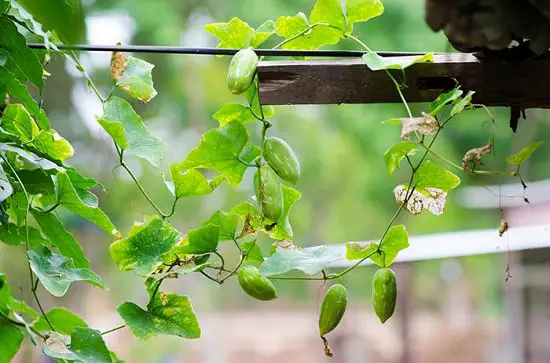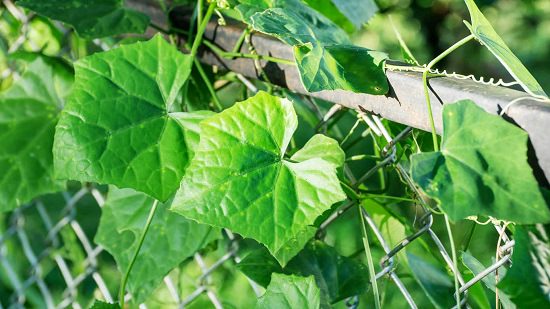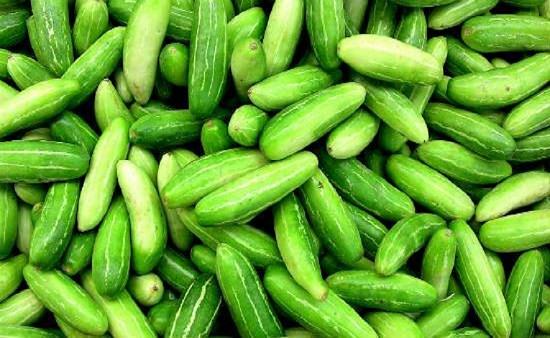Learn everything about Ivy Gourd aka perennial cucumber. Growing Ivy Gourd and its care is easy. The unique taste of this vegetable makes it a must grow.
What is Ivy Gourd?
Ivy gourd is a member of the cucumber family, and it’s fruit somewhat resembles cucumber in taste. The only difference is in the size of the fruits–they are about two inches long, a way too smaller than the cucumbers. Young leaves of ivy gourd are also edible and considered a good substitute for spinach in Thailand. It is native to the Indian subcontinent and usually grown as a vegetable in subtropical and tropical climates of South-East Asia, South Asia, and Africa.
Also Read: How to Grow Spinach
This aggressive grower is considered invasive: A declared weed in Western Australia, Florida, Hawaii, and Texas as it grows rapidly and covers everything up from fences, trees, shrubs to any other supports within its reach and ultimately smother them with its vigorous growth. In a favorable climate, it can be the easiest to grow vegetable and very productive.
Botanical Name: Coccinia Grandis
Common Names: Baby watermelon, Little gourd, Tondli, Gentlemen’s Toes, Tindora, Kundru, Scarlet Gourd, Calabacita, Calabaza Hiedra, Coccinia Cordifolia, Coccinia Grandis, Coccinia Índica, Courge Écarlate, Kovai, Little Gourd, Tela Kucha, Tindola, Kowai fruit, Tondli, Tendli, Thai Spinach, Phak Khaep, Small Gourd
USDA Zones: 9-11, can be grown in zone 7 and 8 with care
Size: Up to 13 meters tall (42 feet) but can be maintained to 8-10 feet height
Soil pH: Prefers neutral, but tolerates slightly acidic to slightly alkaline soil
Also Read: How to Grow Bitter Gourd
How To Grow Ivy Gourd
Climate
This perennial tropical vine is suitable for warm climatic conditions. Humid climate is also beneficial for the overall growth. So, if you live nearby a seashore, you are in luck! It can also tolerate some cold, and dry climate. But won’t survive in extreme conditions such as regular heavy rainfalls and extreme cold and frost.
Note: Ivy gourd has deep roots, and it might come back in spring after freezing in the cold, down to USDA Zone 7 when grown outdoors.
Ivy Gourd Varieties
Ivy gourd is mainly classified from the appearance of its fruit. Fruits with stripes come under striped Ivy. Plain skinned, green fruits come under non-striped Ivy.
Also Read: How to Grow Moringa Tree
Ivy Gourd Propagation
There are two ways to propagate Ivy gourd, from seeds or cuttings:
Growing Ivy Gourd From Seeds
Buy the seeds online or just get a ripe, scarlet colored tindora fruit to remove seeds from it for sowing. You can start seeds anytime if you live in a tropical or subtropical climate, except peak summers. If you’re growing ivy gourd from seeds in a cool climate, do this in spring and summer, when the weather is warm. The ideal germination temperature is between 60-80 F (15-27 C).
Transplanting Seedlings
If you live in a hot climate, transplant seedlings when the temperature is optimum, except for the hot summer. In cooler regions, wait for the passage of the last frost to pass before transplanting.
- Choose a site that receives full sun. Till the soil well and add a lot of compost or well-rotted manure at the planting site.
- Plant the young plants the way you usually do. Each seedling should be sufficiently spaced apart.
- Install a pole or trellis nearby the plant at the time of transplanting.
Drawbacks of Growing Ivy Gourd from Seeds
- One of the major drawbacks of growing ivy gourd from seeds is it may not grow true and start as a dioecious plant. In that case, it will never fruit unless you grow a male and female plant together.
- Ivy gourd grown from seeds takes time to start production. This vegetable vine may take another year to fruit.
Ivy Gourd Propagation from Cuttings
Propagation from cutting is super easy and assures you that your ivy gourd will fruit, that is why it’s more common and successful. All you need to do is take a semi-hardwood cutting from a healthy stem of the self-fertile plant, which is about six-eight inches in length. Make sure that you go for a sturdy cutting which is well trimmed.
Buy Ivy Gourd Plants
The most straightforward way it to find ivy gourd plants for sale online or in your nearby nursery, buy and plant them.
Requirements For Growing Ivy Gourd
Position
Find a spot where it can receive full sun. It may grow well in the partial shade as well. In the initial stage when the roots are establishing, protect the plant from the afternoon sun. The plant may grow in the shade also but will not produce fruits.
Soil
Ivy gourd is a no demand vegetable vine that can even grow in poor and heavy soils. If growing on the ground, opt for a little sandy soil rich in compost or manure. Avoid very poor drainage. Well-draining, loose and porous soil mix is ideal when growing it in containers.
Watering
Water regularly as ivy gourd prefers moist soil over dry. During hot or windy weather and when the plant is young, keep the soil evenly moist.
Fertilizer
Mixing a lot of compost or well-rotted manure at the time of planting will provide enough nutrients to plant. Also, side dressing the plant with compost, once or twice in a year will end the need of additional fertilizer.
Support
Install a climbing frame, stake or pole nearby the planting site from the beginning, or it’ll find the way on its own, trampling one of your favorite shrubs or covering the tree. The vine can grow very tall, in fact, huge if you do not trim it. More than 13 meters (42 feet) tall. You can use it as a pergola plant as well if you live in a frost-free climate.
Also Read: Cucumber Trellis Ideas
Ivy Gourd Plant Care

It is a low maintenance plant and does not require much care. Still, for a bountiful harvest make a note of these ivy gourd plant care points.
Pruning
Ivy gourd overgrows and can turn invasive if left unchecked. So, it’s important that you prune off the stems that are growing out of limit. Make sure that the pruning shear is sharp and well-oiled. After pruning dispose of the fallen stems, or they might root.
Once the plant has stopped producing after the fruiting season, you can prune it off, leaving only 2-3 feet of thick bottom stem left. The fresh growth will start from it again.
You can skip pruning the plant if you’re living in the warm climate and growing it for the ornamental or privacy purpose.
Pests and Diseases
Usually, the ivy gourd is a tough and strong climbing vegetable that doesn’t get affected by any serious pests and diseases. But keep a close watch for common garden pests such as aphids, mites, thrips, and whiteflies. If the infestation is severe, you can use pesticides or go for some herbal remedies to get rid of them.
Weeding
Ivy gourd is an invasive vine, its branches touching the ground can root and start a new plant. Seeds, fallen on the ground can germinate aggressively. Keep an eye on it avoid this situation–remove the fallen fruits, pick up the trimmed stems and don’t let the branches come near the soil. Alternatively, you can also plant it in containers.
Also Read: Effective Weeding Tips
Growing Ivy Gourd in Pots
Growing ivy gourd in pots is a good idea if you live in a cool climate and want to grow this. Plant it if you’re an urban balcony gardener, or you don’t want it to spread in your yard.
- Start growing this plant in a large 16 inches pot or select a medium-sized 5-gallon pot with 10-12 inches depth.
- Once it becomes something bigger (it can grow up with a speed of 4 inches a day), move it in a much larger pot.
- Choose a sunny location. Afternoon shade is good for this plant.
- Use regular potting soil and add 1/4 of compost or aged manure to it.
- Water it regularly, keep the soil evenly moist in the initial stage. It prefers slightly moist growing medium.
- Side dress the plant with compost or aged cow manure. If it’s not doing well, feed the plant with a balanced liquid fertilizer.
- Also, feed the plant occasionally with potassium-rich fertilizer. This article at The Guardian is very helpful.
- Provide support so that it can climb. It’ll use your vertical space.
- Maintain its height between 6-10 feet. All the other growing tips are similar.
Also Read: Growing Cucumbers Vertically
Harvesting
In optimum conditions, around three months after planting it’ll start to produce flowers and set fruits. Fruit production is at such a high rate that you’ll have to harvest daily. Either snip off the fruits using a sickle or handpick them. Don’t wait for too long, harvest them when they are still young bulbous and green.
TIP: Ivy gourd fruits are usually harvested young when the fruits are firm, crunchy and around 1.5-2 inches in size. You can taste them raw to identify the right time. Leave them for a long time to overripe, and they’ll turn beautiful scarlet but taste ugly.
Ivy gourd cultivation gives you not just the fruits. You can also harvest its young and tender leaves and top shoots. Use them as a side dish with rice, bread or naan, in soups or try to prepare a gourmet Thai or Indian curry.
Store Seeds
To obtain seeds, cut open the overripe unblemished scarlet or red colored fruit and scoop out the seeds. Place them on the paper towel and let them dry. Clean and dry seeds are ready for storage.
Ivy Gourd Benefits, Uses, Effects, and Nutrition
Ivy gourd is also known as a little gourd or perennial cucumber. This wild cousin of cucumber is crunchy, slightly sweet and tart, and a bit juicy in taste when eaten raw. Add this vegetable in the salad or stir-fry it. You can prepare tasty pickle or make a delicious ivy gourd curry. The internet is full of recipes.
Also Read: How to Start a Salad Bowl Garden
There are many health benefits of it too. It’s considered a medicinal plant and all parts are useful. It’s a good source of good source of protein, calcium, fiber and beta-carotene, Vitamin-A. Iron and potassium are two important constituents. It reduces blood sugar levels as well.
Also Read: Snake Plant Health Benefits






Great article! Thank you. I just received seeds that I ordered from Thailand. I hope they will bare fruit.
Update: They grow and flower like crazy but the tiny fruit falls off with the bloom. I planted two together hoping I would have a fertile plant but it seems I just have a monster that makes flowers sans the fruit. :(
It is very likely that it is not being pollinated. Plant flowers that attract pollinators near it.
Hey I am living in India, Please suggest good balcony plants.
I have ivy gourd plant from one year. There are lots of flowers in plants but not converting in fruits. Just become very tiny fruits and fell down. Any tips please
Hello, I am from India, Thanks for sharing your blog. Please share the link where I can buy the seeds.
If you get this plant, make sure it is infertile-type. That is very important because this plant is highly invasive. If some hidden fruit gets very ripe and birds eat that fruit, the birds will spread the seeds all over the place and this plant will take over and smother out native plants. Must get infertile-type. It will still make fruit but not able to spread the plant around through seeds.
Thank you for your suggestion. I heard about it from the seller. I ordered it and will get it soon.
Hi I want to buy the seeds or plants plz suggest me where can I buy these
I really like them and can’t find anywhere
Plz help if someone can
Thanks in advance
eBay. I don t doubt they re correct plant. Everything you write about them is true except taste. Gotta try and source from a new location. Kinda hard with me living Cough-fl-Cough. Any recommendations? I am hopeful I ll find one that works if not we ll try and try again. Hey, I ve found just about if not 100% of all items in your Totally Crazy Easy FL Gardening and all within a short period of time too. Not growing them all, but a good bit I am. Thank you for doing the hard work of trial and error.
There are seeds for sale through various Etsy sellers. One also sells live plants.
I live in Sydney. I have one tindora vine. It has been flowering, but all the fruits are rotting and eventually falling off. Any ideas why?
I was about to weed out these invasive vines when I thought to look it up. I was very surprised to learn it was pretty valuable nutrition-wise. I added it to soups and broth for us. I also added it to the chicken stew for my cats and dogs. I was amazed by how much they loved it and were snatching it from others’ bowls. The pets have become leaner, more muscular, and gained weight, and their eyes brightened up! Amazing and incredible results.
Since it’s been raining a lot hereabouts, the ivy has been flowering and fruiting like crazy where it’s attached to canopy trees. I noticed that the fruits are always shaded by leaves, never exposed to direct sunlight. In another area where it’s growing wild, exposed to strong and direct sunlight, it’s mostly leaves and flowers and hardly any fruits. Hope this helps!